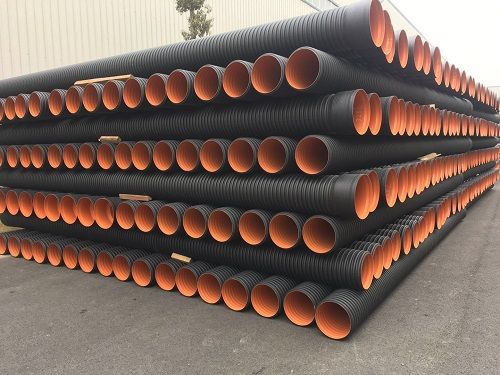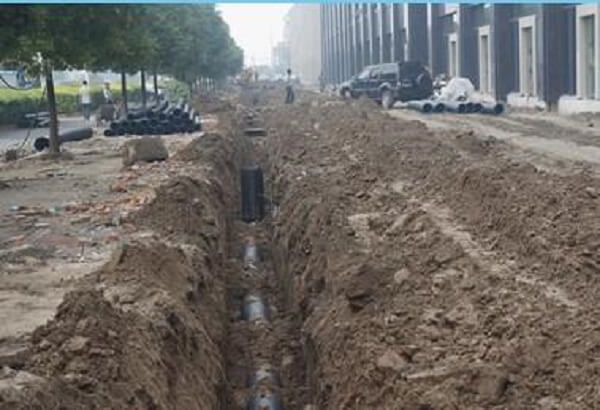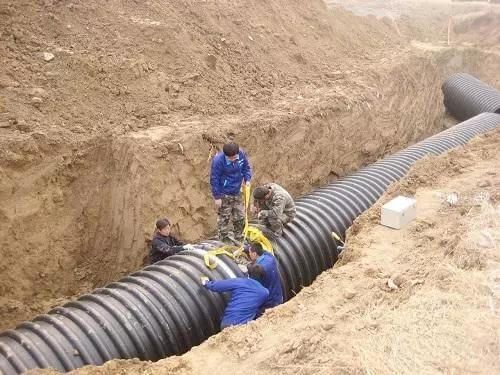HDPE Double wall corrugated pipe is a common sewage and drainage pipe in our life. It is processed and produced with high-density polyethylene as raw material. With its unique structure, it has the characteristics of light weight, high pressure resistance, good toughness, fast construction and long service life. Compared with other pipes, the utility model has the advantages of lower cost, simple connection mode and wide application range.
Application Scope
- Municipal Drainage and sewage pipeline system works;
- Underground drainage and sewage in apartments and residential areas;
- Embedded pipeline of expressway, underground seepage pipe network of golf course;
- Irrigation, water conveyance, drainage and other water conservancy projects;
- Used for fluid transportation and ventilation in chemical industry and mines;
- Protective sleeves for underground pipelines and communication cables.
HDPE Double wall corrugated pipe has various connection modes. The common hot-melt connection includes the following three methods: 1. Electric fusion connection; 2. Socket hot melt connection; 3. Direct hot melt connection.
Many workers often waste materials and often rework due to lack of experience in the installation process, which increases the project cost. Our editor summarized the following mistakes that are easy to make when connecting HDPE Double wall bellows.

Precautions for HDPE Double Wall Corrugated Pipe Connection
- When handling materials, throwing, falling, rolling and dragging are strictly prohibited to avoid damaging the pipeline. Before connecting the pipe, check both ends. If there is any damage, cut off the damaged part.
- Hot melt connection of pipes and fittings. The welding temperature shall be set at 260 ± 10. If there is any discoloration, decomposition, combustion, smoke or other adverse effects, please replace the welder.
- Although the threaded pipe fittings are connected to other parts, they must not be tightened too tightly to avoid damaging the threaded pipe fittings.
- Please strictly follow the arrangement and business standards of HDPE Double wall bellows to ensure quality.
- After installation, a hydrostatic test must be carried out to confirm that there is no leakage, and then the pipe channel can be closed or filled. The test pressure shall be 1.5 times the design pressure. The recommended test pressure is 10kg / cm2 (MPA) - 15 kg / cm2 (1.5MPa).
- When the winter temperature is close to 5 ℃, accidental damage of pipes and fittings shall be prevented during handling and construction.
After the pressure test, the water inside the pipeline shall be drained. During long-term shutdown in winter, there is no reliable thermal insulation measures for the water in the pipeline, which is easy to cause cracks in the pipeline.
Ring Stiffness of HDPE Double Wall Corrugated Pipe
The ring stiffness can reflect its quality, so what is the ring stiffness? The load borne by double wall bellows includes internal pressure and external pressure. Generally, the stress caused by internal pressure is the main factor causing the damage of pipe materials, The form of failure is the excessive deformation and fracture caused by the tensile stress in the pipe wall (plastic pipes are usually caused by creep). In the design, the design calculation is generally carried out according to the internal pressure load, the material and structural data (such as wall thickness) are selected, and then the external pressure load is considered for design checking calculation, and the structural data are modified if necessary. The double wall bellows bears the external pressure load (generally, the internal pressure load is ignored). The form of failure is excessive deformation or buckling instability of pipe materials caused by external pressure load. During the design, the design calculation shall be carried out according to the external pressure load, and the material and structural data shall be selected. The external pressure load is relatively complex, mainly including soil weight, static load generated on the ground, and dynamic load generated by transport vehicles. Plastic buried drainage pipe bearing The loading mechanism is also complex, because the plastic pipe is a flexible pipe. Under the external pressure load, the pipe material and the surrounding soil (backfill material) produce "pipe soil interaction". In other words, the pipe material and the surrounding soil (backfill material) jointly bear the external pressure load.
In other words, the ring stiffness is the load borne by the double wall bellows, which can be divided into internal pressure and external pressure. According to the ring stiffness, the hardness of the pipeline can be roughly judged. In addition, high-quality and low-cost products can also be selected according to the ring stiffness.
Precautions During Backfilling of HDPE Double Wall Corrugated Pipe

-
HDPE Double wall corrugated pipe shall be backfilled immediately after installation and acceptance, and shall be backfilled to twice the pipe diameter above the pipe top;
-
The axillary corner shall be filled with medium sand and coarse sand first;
-
The trench shall be backfilled symmetrically from both sides of inspection wells and other structures at the same time to ensure that the pipelines and structures do not shift. If necessary, limit measures can be taken.
-
The trench backfilling must be carried out manually from the foundation at the bottom of the pipe to within 0.7m above the top of the pipe. It is strictly prohibited to use mechanical bulldozing for backfilling;
-
The backfilling of the part above 0.7m on the pipe top can be backfilled at the same time from the pipe to both sides of the axis by machinery, which can be compacted by mechanical rolling;
-
During backfilling, there shall be no ponding in the trench, no backfilling with water, no backfilling with sludge, organic matter and frozen soil, and the backfill shall not contain stones, bricks and other miscellaneous hard objects;
-
The compactness of the backfill soil used at each part of the groove edge shall be in accordance with the design requirements or the requirements of cecs122:2001 technical specification.
Laying Standard of HDPE Double Wall Corrugated Pipe

-
the pipes of double wall corrugated pipes shall be laid in a straight line. In case of special circumstances requiring flexible interface broken line laying, the allowable angle of the longitudinal axis of two adjacent pipes shall not be greater than 2 °.
-
It shall be laid on the undisturbed soil foundation or the stratum treated and backfilled after slotting. When the pipeline is under the carriageway, the thickness of soil covering on the pipe top shall not be less than 0.7m.
-
When the pipeline crosses obstacles such as railway, high-grade road embankment and structures, protective casing made of reinforcement, cast iron and other materials shall be set. The inner diameter of the casing shall be more than 200mm larger than the outer diameter of the bellows. The casing design shall be carried out in accordance with the relevant provisions of the embankment.
-
In the area where the groundwater level is higher than the elevation of the bottom of the excavated trench, measures shall be taken to reduce the groundwater level during construction to prevent the instability of the trench. The pipeline installation can be carried out only when the groundwater level drops to 0.3m-0.5m from the lowest point of the trench bottom. During the whole process of installation and backfilling, there shall be no ponding or freezing at the trench bottom.